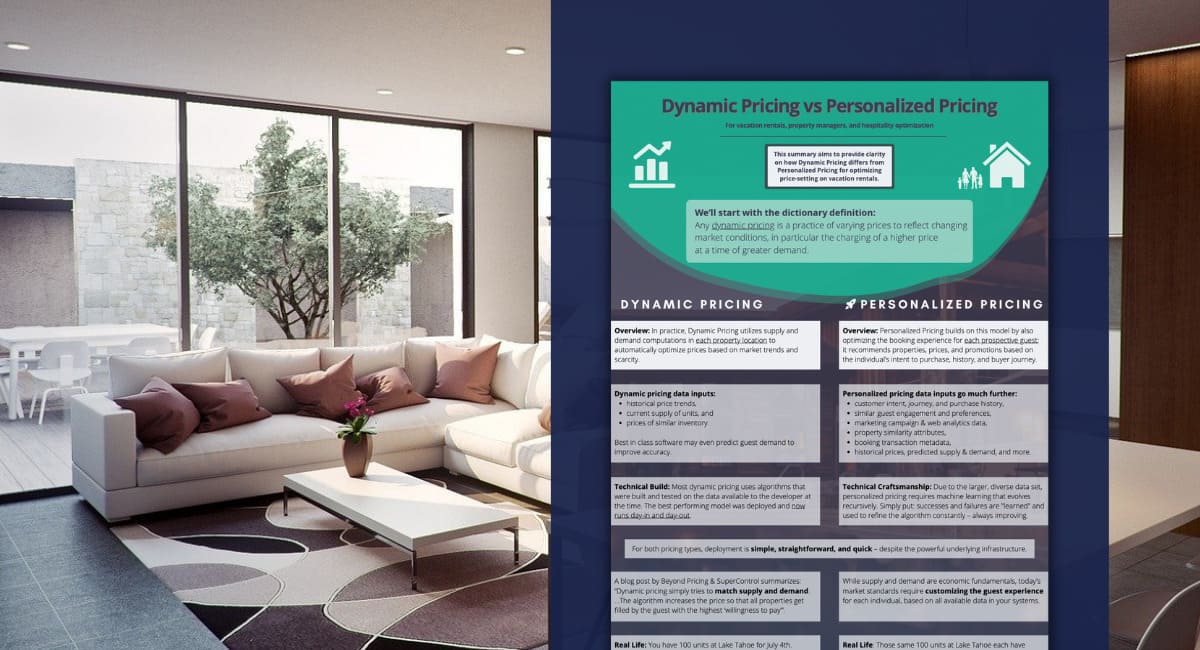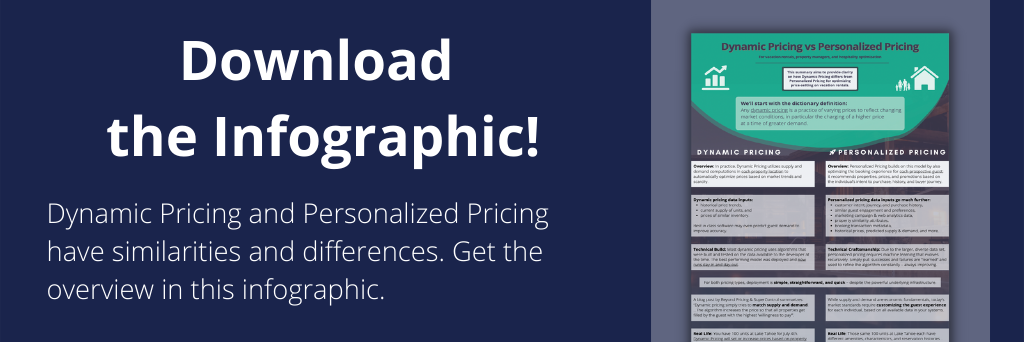Dynamic Pricing vs Personalized Pricing – what is the difference for vacation rental and property management? We created an infographic to help break it down clearly. You can download the infographic PDF here.
This summary aims to provide clarity on how Dynamic Pricing differs from Personalized Pricing for optimizing price-setting on vacation rentals. We’ll spell it out here as a teaser!
We’ll start with the dictionary definition: Any dynamic pricing is a practice of varying prices to reflect changing market conditions, in particular the charging of a higher price at a time of greater demand.
The overview
In practice, Dynamic Pricing utilizes supply and demand computations in each property location to automatically optimize prices based on market trends and scarcity.
Personalized Pricing builds on this model by also optimizing the booking experience for each prospective guest; it recommends properties, prices, and promotions based on the individual’s intent to purchase, history, and buyer journey.
The breakdown
Dynamic pricing data inputs:
- historical price trends,
- current supply of units, and
- prices of similar inventory.
Best in class software may even predict guest demand to improve accuracy.
Personalized pricing data inputs go much further:
- customer intent, journey, and purchase history,
- similar guest engagement and preferences,
- marketing campaign & web analytics data,
- property similarity attributes,
- booking transaction metadata,
- historical prices, predicted supply & demand, and more.
Regarding the technical build: Most dynamic pricing uses algorithms that were built and tested on the data available to the developer at the time. The best performing model was deployed and now runs day-in and day-out.
Due to the larger, diverse data set, personalized pricing requires machine learning that evolves recursively. Simply put: successes and failures are “learned” and used to refine the algorithm constantly – always improving.
For both pricing types, deployment is simple, straightforward, and quick – despite the powerful underlying infrastructure.
A blog post by Beyond Pricing & SuperControl summarizes: “Dynamic pricing simply tries to match supply and demand. …The algorithm increases the price so that all properties get filled by the guest with the highest ‘willingness to pay’”. While supply and demand are economic fundamentals, today’s market standards require customizing the guest experience for each individual, based on all available data in your systems.
Real life scenarios
You have 100 units at Lake Tahoe for July 4th. Dynamic Pricing will set or increase prices based on property market conditions throughout the year, relying on supply, demand, and historical pricing. This increases earnings and reduces manual revenue management work. However, your bottom line isn’t optimized.
Those same 100 units at Lake Tahoe each have different amenities, characteristics, and reservation histories… and each guest has their own unique profile. Personalized pricing will match any engaged guests to their best match property at the optimal price/package to both secure the booking and optimize your revenue growth.
Summary
In summary, Personalized Pricing saves you time, generates higher overall returns, and customizes the guest experience. The combined property-centric and customer-centric methodology maximizes both conversion rates & profit margin. Dynamic Pricing is powerful to replace manual workload – but the limitations of a solely property-centric approach miss out on all the benefits of personalizing your guest experience.






